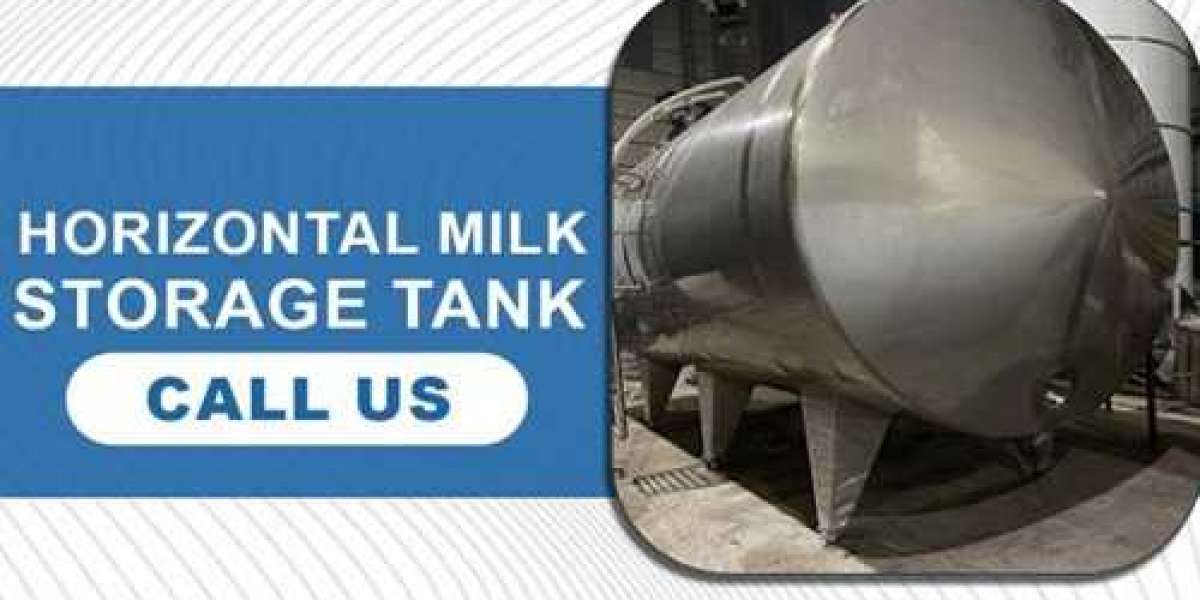Milk storage is a critical process involved in the dairy industry, and the proper selection of equipment guarantees product safety and efficiency. It is one of the most commonly used tanks in dairy farms and milk-processing units, for its design, which saves space; for its durability; and for its superior cooling features. Deciding on a tank requires knowledge of the required qualities which go into good storage and long-life tanks. Listed below are some of the main features to look for in a horizontal milk storage tank for dependable milk preservation and smoother dairy operations.
1. Stainless Steel Construction
Some of the most important features of a horizontal milk storage tank are related to the material of construction. Hardened stainless steel, especially SS304 or SS316 grades, would provide resistance to corrosion, long life, and hygiene in storage. The stainless steel could not contaminate the milk and is easy to clean, as well as undergoing fluctuations in temperature. It resists rust in humid environments too, which is important. Stainless steel tanks would protect the milk's integrity and abide by food safety norms.
2. Good Insulation for Temperature Maintenance
Excellent insulation must be offered by a horizontal milk storage tank to maintain the required temperature of the milk, which is generally around 4°C. Tanks with insulation in polyurethane foam (PUF) or double jacket are recommended because these materials minimize the heat exchange and lessen the energy required for cooling. Good insulation preserves freshness by slowing down bacterial germination and evaporation through the evaporation process. When it gets tougher to keep quality during long-term storage or transport delay, insulation quality becomes significant in preserving milk.
3. Integrated Cooling System
An integrated/external cooling system is another important feature of horizontal milk storage tanks. Rapid cooling helps in reducing quickly the temperature of freshly collected milk, which is very important for maintaining all its nutritional properties. The tank should be compatible with DX or ice bank cooling systems. With temperature sensors and digital control panels, one can conveniently monitor the tank in real time and automatically adjust the temperature. A reliable cooling system assures steady operations even in high ambient temperature conditions.
4. Easy to Clean and Maintain
A CIP system and smooth inner surface and design are indispensable in a horizontal milk storage tank. Dairy is a hygiene-sensitive operation, and hence tanks with easy-clean facilities prevent bacteria's development and milk spoilage. Also, rounded edges, polished interiors, and detachable fittings should be considered in order to clean the tanks either manually or mechanically with ease. The design should allow faster drainage and minimize milk residue after emptying so that regular cleaning cycles are both quicker and more thorough.
5. Capacity and Agitator Functionality
The correct capacity is determined by the scale of your business. Whether you require 500 liters or 10,000 liters, the horizontal milk storage tank should be able to meet your volume requirements without frequent refills and wastage. Further, an inbuilt agitator is also needed for ensuring uniform milk by checking on cream separation. The agitator should work ideally at a lower speed to mix milk gently without air incorporation, which leads to foaming and eventual deterioration in quality.
Why Gemak Engineering Solutions?
Gemak Engineering Solutions undoubtedly is a name to trust while investing in making a good horizontal milk storage tank. Due to their precision engineering, durability, and commitment to customer satisfaction, Gemak provides dairy tanks that have all the critical features outlined above. Tanks of Gemak are made from premium stainless steel and employ the best insulation and cooling systems, with easy cleaning designs suitable for use by both small dairies and large-scale milk processors.
Conclusion
The deciding factors of a horizontal tank for milk storage include dairy efficiency, product quality, and the attainment of regulatory standards. The features like materials used for construction, insulation, cooling systems, and the ease of maintenance therefore become equally important to hold milk stored under optimum conditions. This well-equipped tank will protect your milk resources and will ease your dairy operation processes. When it comes to the aspects of strength and features, rely on those manufacturers, such as Gemak Engineering Solutions, who appreciate the changing demands of the dairy industry and therefore design manufactured products for active service and endurance.
Here are 3 FAQs
Q1. Why should one opt for a horizontal milk storage tank as compared to a vertical one?
A: A horizontal milk storage tank is selected by a dairy plant with limited vertical space. These tanks are easier to clean, offer better stability than vertical ones, and cool the milk faster as a result of having a much greater surface area in contact with the cooling system.
Q2. How is hygiene maintained in horizontal milk storage tanks?
A: Apart from cleaning, inspect the inner surfaces for a smooth stainless steel finish, CIP possibilities, and proper drainage. Any temporary incursions into routine cleaning cycles may result in bacterial contamination.
Q3. How many capacities are available in horizontal milk storage tanks?
A: Capacities of horizontal milk storage tanks vary widely, with storage sizes ranging from as few as 500 liters to over 10,000 liters, suitable for smaller farms as well as large milk processing plants.








